中考英语语法考点总结——动词(共33张PPT)
文档属性
| 名称 | 中考英语语法考点总结——动词(共33张PPT) | 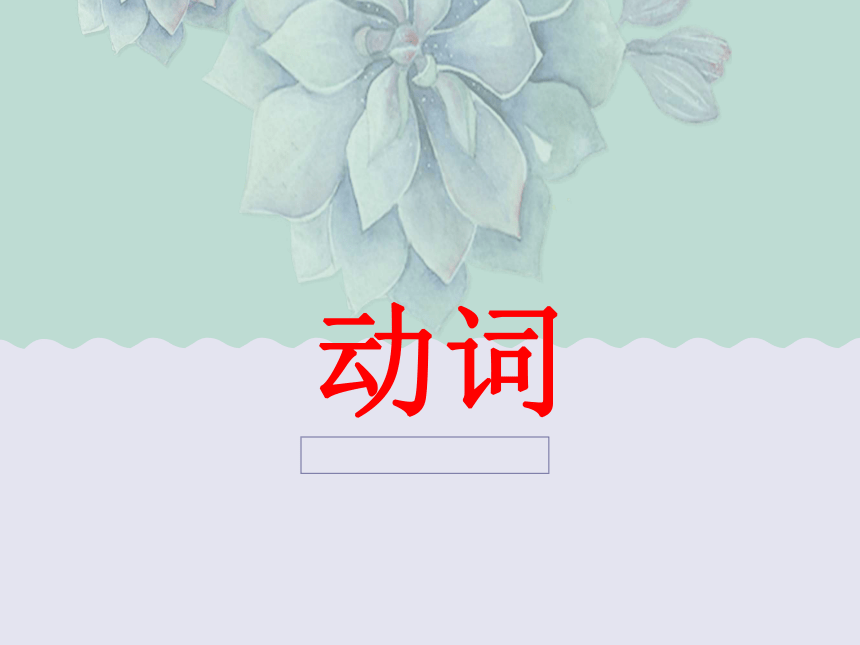 | |
| 格式 | ppt | ||
| 文件大小 | 3.2MB | ||
| 资源类型 | 试卷 | ||
| 版本资源 | 通用版 | ||
| 科目 | 英语 | ||
| 更新时间 | 2022-04-10 18:52:00 | ||
图片预览

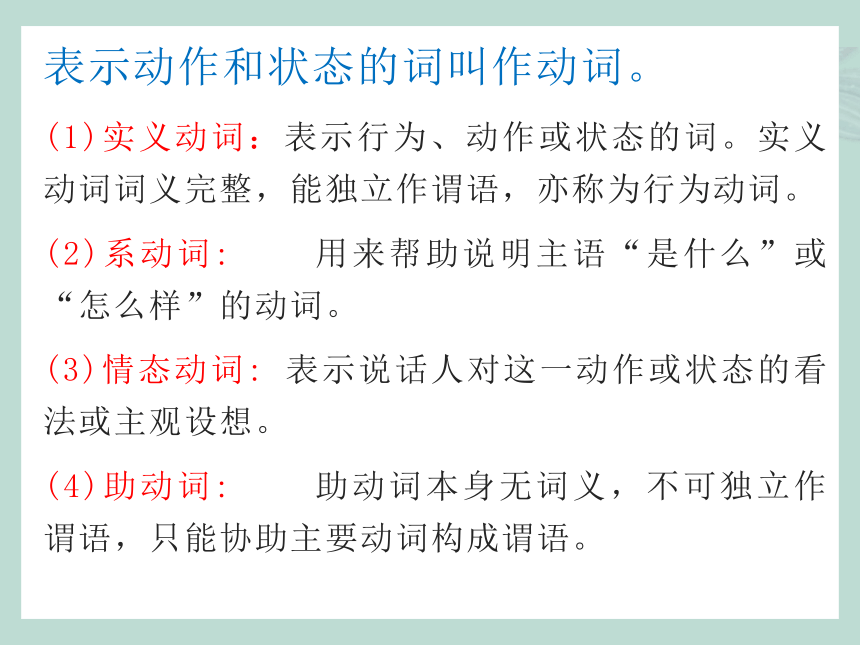
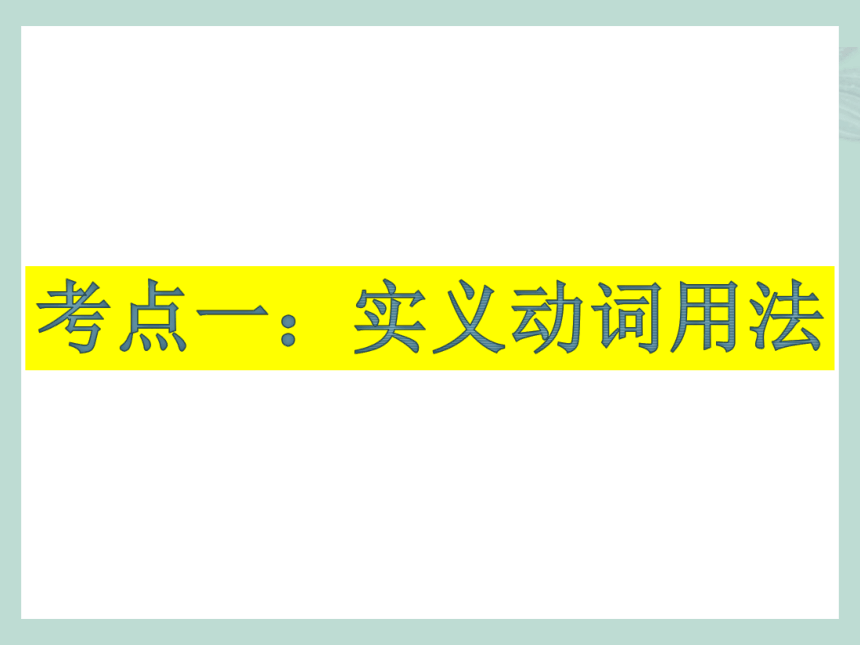
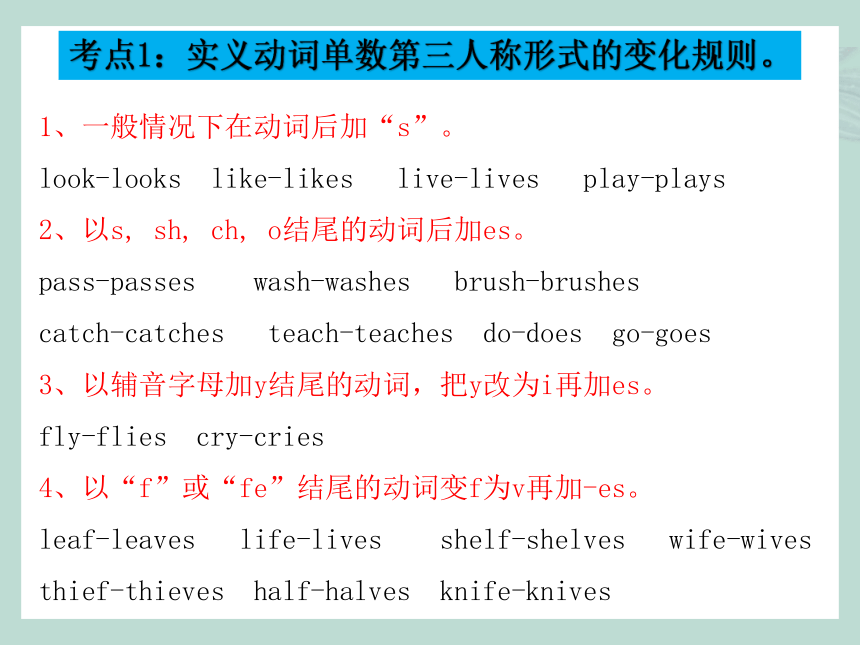
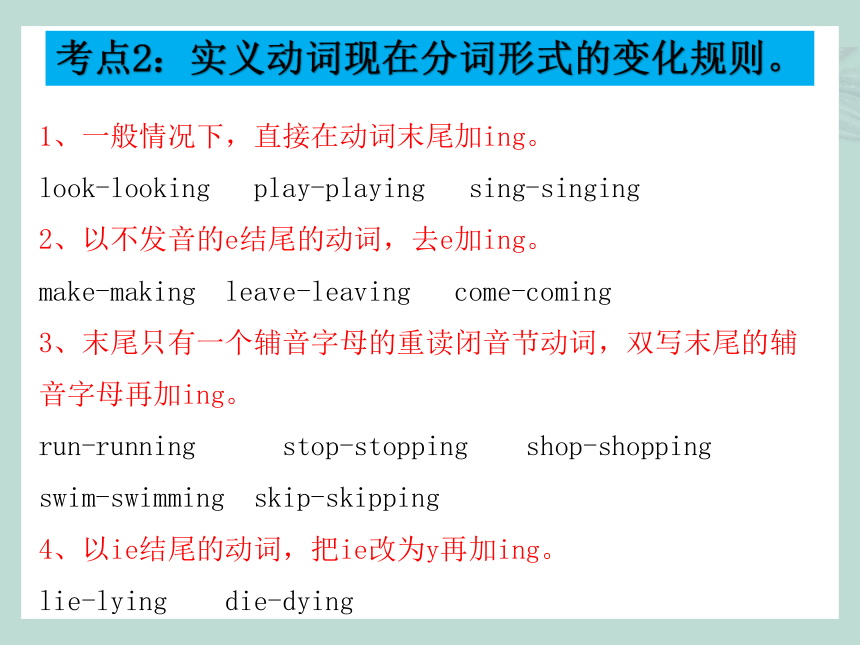

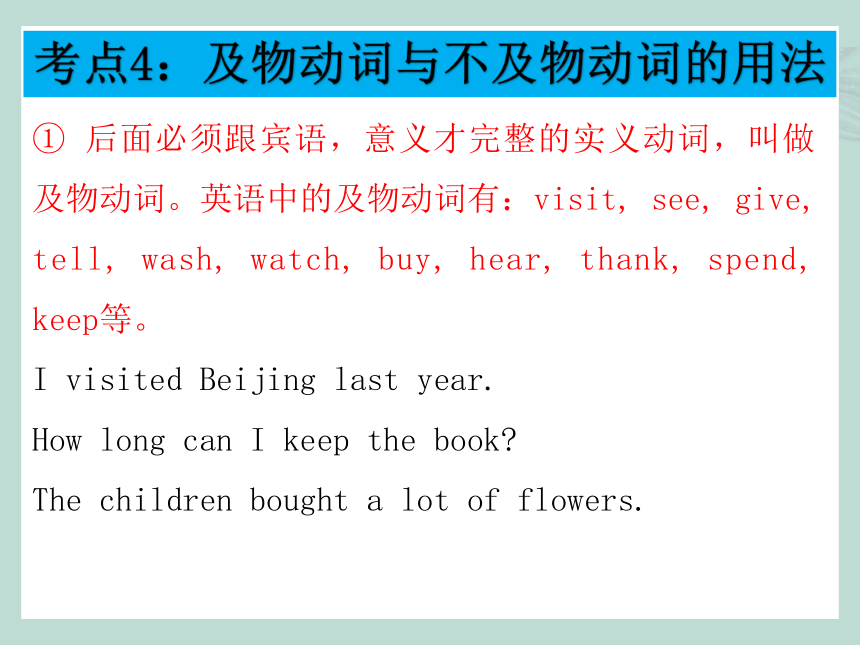
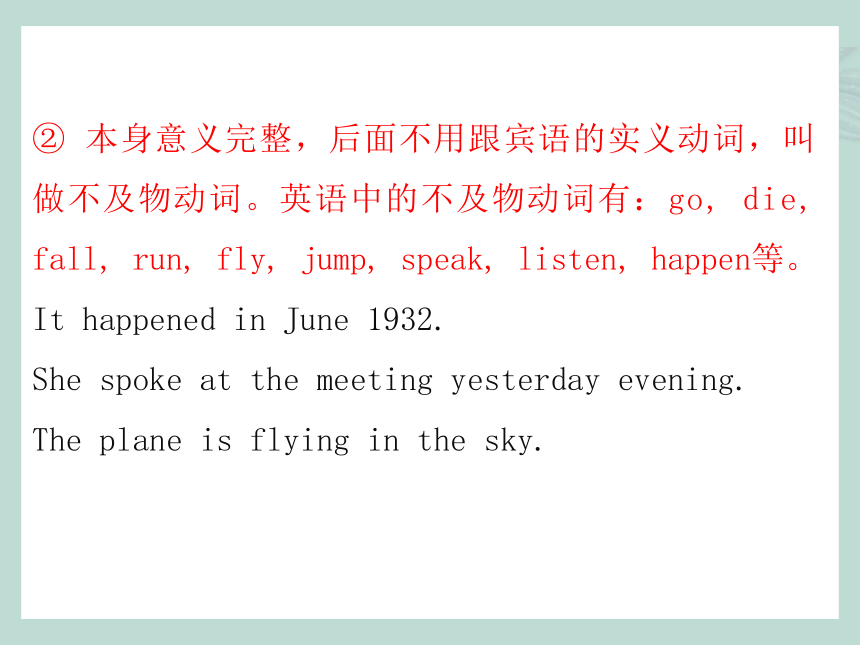
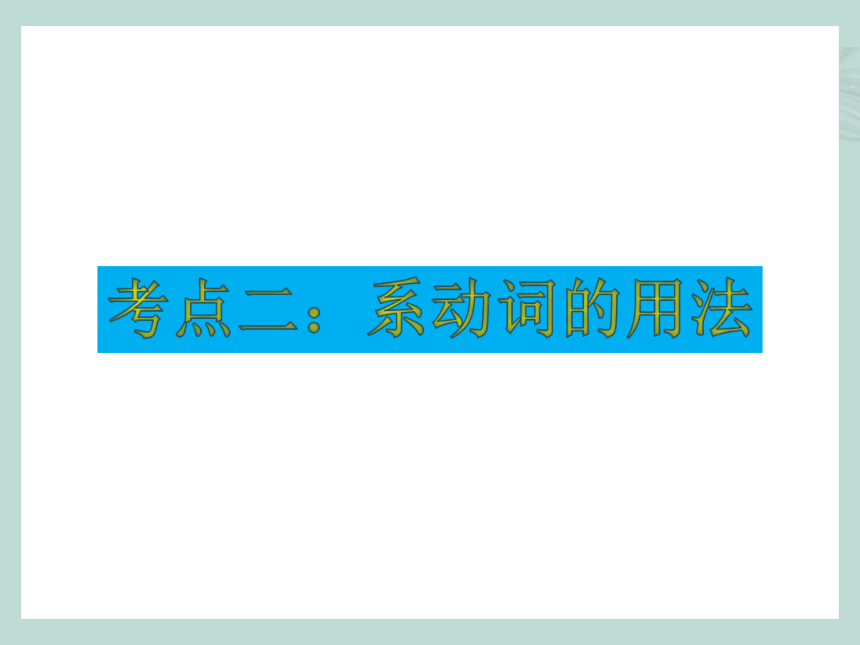
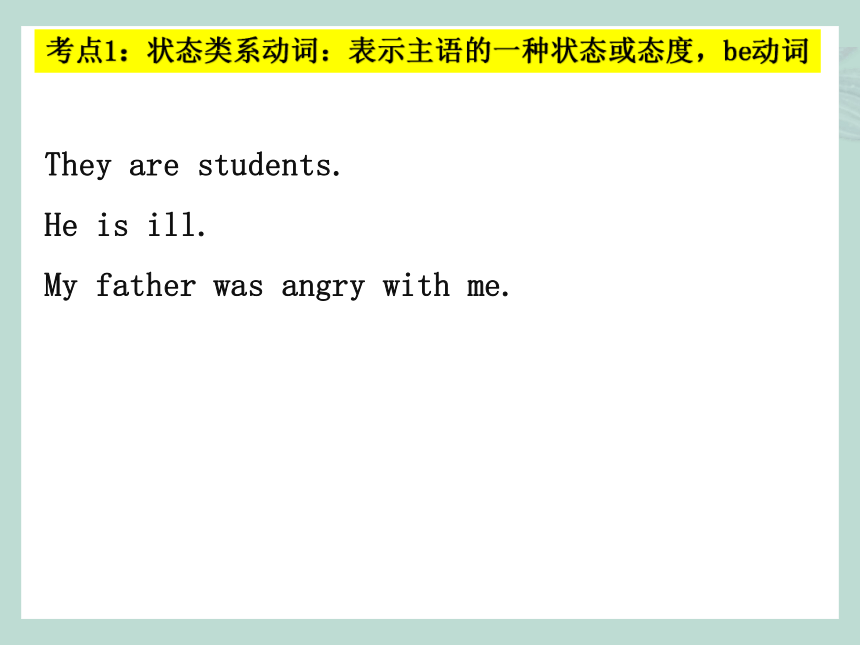
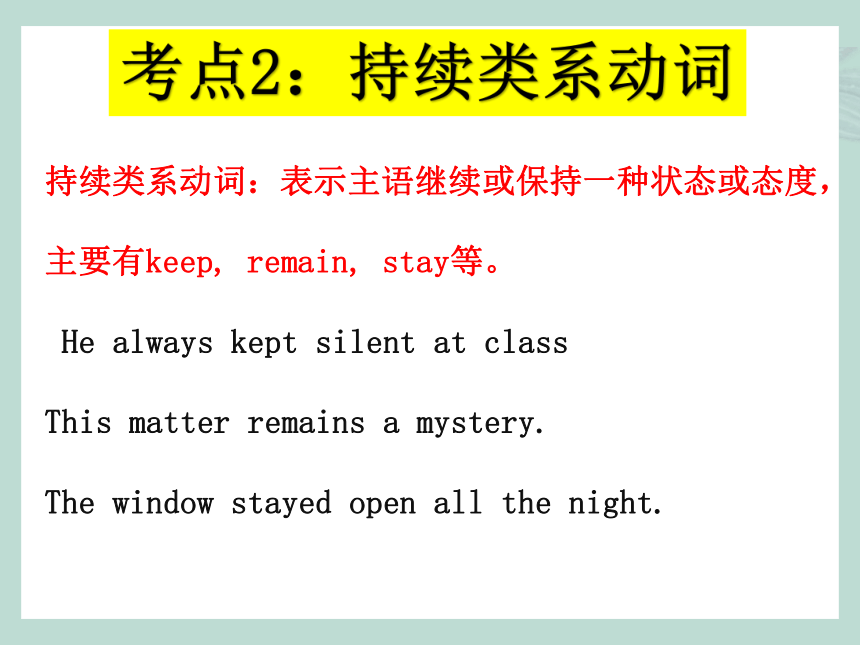
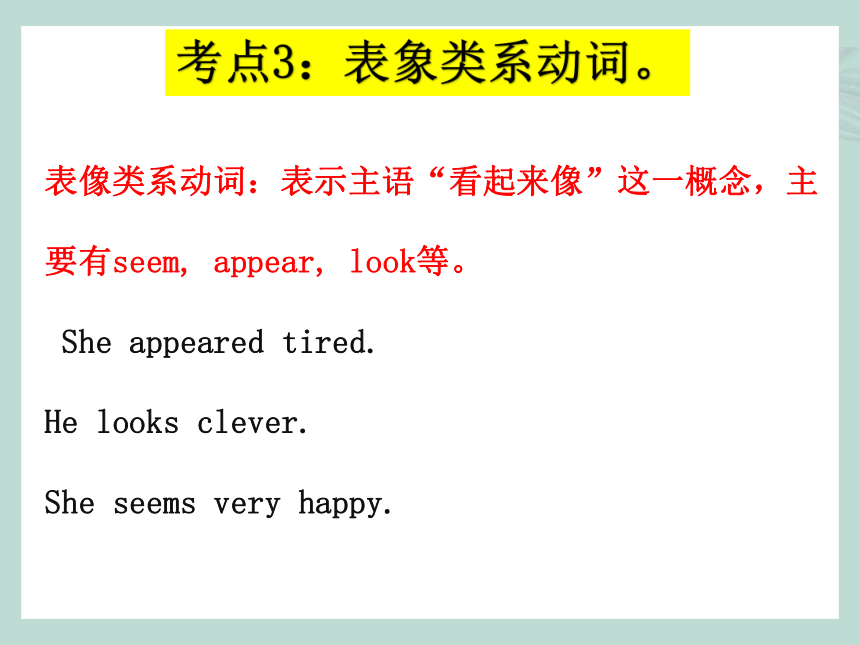
文档简介
(共33张PPT)
动词
表示动作和状态的词叫作动词。
(1)实义动词:表示行为、动作或状态的词。实义动词词义完整,能独立作谓语,亦称为行为动词。
(2)系动词: 用来帮助说明主语“是什么”或“怎么样”的动词。
(3)情态动词: 表示说话人对这一动作或状态的看法或主观设想。
(4)助动词: 助动词本身无词义,不可独立作谓语,只能协助主要动词构成谓语。
考点1:实义动词单数第三人称形式的变化规则。
1、一般情况下在动词后加“s”。
look-looks like-likes live-lives play-plays
2、以s, sh, ch, o结尾的动词后加es。
pass-passes wash-washes brush-brushes
catch-catches teach-teaches do-does go-goes
3、以辅音字母加y结尾的动词,把y改为i再加es。
fly-flies cry-cries
4、以“f”或“fe”结尾的动词变f为v再加-es。
leaf-leaves life-lives shelf-shelves wife-wives
thief-thieves half-halves knife-knives
考点2:实义动词现在分词形式的变化规则。
1、一般情况下,直接在动词末尾加ing。
look-looking play-playing sing-singing
2、以不发音的e结尾的动词,去e加ing。
make-making leave-leaving come-coming
3、末尾只有一个辅音字母的重读闭音节动词,双写末尾的辅音字母再加ing。
run-running stop-stopping shop-shopping
swim-swimming skip-skipping
4、以ie结尾的动词,把ie改为y再加ing。
lie-lying die-dying
考点3:实义动词过去式的变化规则
1、一般情况在动词末尾加-ed。
look-looked miss-missed play-played
2、以e结尾的动词直接在词尾加d。
arrive-arrived hate-hated
3、末尾只有一个辅音字母的重读闭音节动词,双写末尾的辅音字母,再加-ed。
stop-stopped shop-shopped
4、以“辅音字母+y”结尾的动词,变y为i,再加-ed。
study-studied carry-carried
考点4:及物动词与不及物动词的用法
① 后面必须跟宾语,意义才完整的实义动词,叫做及物动词。英语中的及物动词有:visit, see, give, tell, wash, watch, buy, hear, thank, spend, keep等。
I visited Beijing last year.
How long can I keep the book
The children bought a lot of flowers.
② 本身意义完整,后面不用跟宾语的实义动词,叫做不及物动词。英语中的不及物动词有:go, die, fall, run, fly, jump, speak, listen, happen等。
It happened in June 1932.
She spoke at the meeting yesterday evening.
The plane is flying in the sky.
考点1:状态类系动词:表示主语的一种状态或态度,be动词
They are students.
He is ill.
My father was angry with me.
考点2:持续类系动词
持续类系动词:表示主语继续或保持一种状态或态度,主要有keep, remain, stay等。
He always kept silent at class
This matter remains a mystery.
The window stayed open all the night.
考点3:表象类系动词。
表像类系动词:表示主语“看起来像”这一概念,主要有seem, appear, look等。
She appeared tired.
He looks clever.
She seems very happy.
考点4:感官类系动词
感官类系动词:主要有feel, smell, sound, taste, look等。
This kind of paper feels very soft.
This flower smells very sweet.
The apples taste very good.
考点5:变化类系动词
变化类系动词:表示主语变成什么样,主要有become, grow, turn, fall, get, go, come, run等。
She become mad after that.
He grew rich within a short time.
The days are getting longer and longer.
考点1:can和could的用法
① 表示能力,意为“能,会”。
She can drive, but she can’t ride a bike.
I hope to offer you some useful advice.
He can give you some books.
② 表示请求或允许,意为“可以”。
Can I use your telephone?
You can go now.
We can ask her for help.
③ could是can的过去式,表示过去的能力。
I could swim all the way across the lake,but I can’t now.
He could cook when he was young.
He could be saved, but he wasn’t sent to hospital in time.
④ 表示请求时,could的语气比can更加委婉,肯定回答用can,而不用could。
--- Could you lend your car to me
--- Of course, I can.
考点2:may和might的用法
① 表示请求或允许,意为“可以”。其否定回答用mustn’t或can’t,意为“不可以、不允许、禁止”,不可用may not。
You may go home now.
May I have a word with you,please?
May I have it
---May I go now
---No, you mustn’t.
② 表示推测,意为“可能、也许”,用于肯定句中。
He may be at home.
They may come tomorrow.
③ might是may的过去式,表示推测时,可能性比may小。
He might go to see the doctor.
She might get angry with you.
考点3:must的用法
① 表示必须,否定式为mustn’t,意为“禁止”。
I must go now.
We must study hard.
You mustn’t play with fire.
② 表示推测,意为“一定”,只用于肯定句中,否定句中用can’t。
The man over there must be my father.
That girl on the playground can’t be my sister, because she has gone abroad.
③ 以must开头的疑问句,肯定回答用must,而否定回答则用needn’t或don’t have to,意为“不需要、不必”,而不能用mustn’t。
---Must I hand in the homework now
---No, you needn’t / don’t have to.
考点4:need的用法
① need作情态动词用时,没有人称和数的变化,直接接动词原形,只用于否定句和疑问句中,构成否定句和疑问句时不用助动词。用need提问时,肯定回答用must,否定回答用needn’t。
You needn’t do it.
---Need I come here tomorrow
---Yes, you must / No, you needn’t (don’t have to).
② need作行为动词时,有人称和数的变化,可用于肯定句、否定句或疑问句中,构成否定句和疑问句时要用助动词do, does, did。
The boy needs the parents’ love.
The flowers in the park needed a lot of water.
考点5:shall和should的用法
① shall用于第一人称,表示征求对方意见。
Shall I open the window
Shall we have lunch at a restaurant
② should 用来表示义务、责任,意为“应该”。
We should obey the traffic rules.
The children should listen to their parents.
考点6:will和would的用法
① will表示请求、询问或意愿。
Will you help me with my English
He will do anything for his family.
② would用来表示过去的意愿或委婉的询问。
When I was young, I would do a lot of hard work.
Would you please tell me how to get to the zoo.
Would you like to come to my party
考点7:情态动词易混点
① can和be able to表示能力时,can只用于一般现在时和一般过去时,其他时态要用be able to。另外,表示成功做成某事时,用be able to。
Tom couldn’t ride the bike, but now he can.
He will be able to came back in three days.
A big fire took place in the house, but all the people were able to escape from it.
② must和have to均表示“必须”,但must强调主观意愿,have to强调客观需要。
We must study hard at school.
The sun is setting and I have to go home.
③ could, would, might等有时并不表示过去,而是表示委婉客气的语气。
Could I use your pen
Would you mend the bike for me
考点1:助动词be的用法
助动词be用来构成进行时态(be+现在分词)和被动语态(be+过去分词)。
We are working hard in the garden.
Look, some girls are singing in the classroom.
The house was painted purple.
考点2:助动词do, does, did的用法
助动词do, does, did用来构成疑问句和否定句。
He doesn’t like to have hamburgers.
Did you live in Shanghai
考点3:助动词have, has, had的用法
助动词have, has, had用来构成完成时态。
Had you finished the work before he came back
Have you had a ticket
He has learned English for 10 years.
考点4:助动词shall和will的用法
助动词shall和will用来构成将来时态(shall用于第一人称,will可用于所有人称)。
I will call you this evening.
What shall we do next week
He asks me when we will leave.
THANK YOU
动词
表示动作和状态的词叫作动词。
(1)实义动词:表示行为、动作或状态的词。实义动词词义完整,能独立作谓语,亦称为行为动词。
(2)系动词: 用来帮助说明主语“是什么”或“怎么样”的动词。
(3)情态动词: 表示说话人对这一动作或状态的看法或主观设想。
(4)助动词: 助动词本身无词义,不可独立作谓语,只能协助主要动词构成谓语。
考点1:实义动词单数第三人称形式的变化规则。
1、一般情况下在动词后加“s”。
look-looks like-likes live-lives play-plays
2、以s, sh, ch, o结尾的动词后加es。
pass-passes wash-washes brush-brushes
catch-catches teach-teaches do-does go-goes
3、以辅音字母加y结尾的动词,把y改为i再加es。
fly-flies cry-cries
4、以“f”或“fe”结尾的动词变f为v再加-es。
leaf-leaves life-lives shelf-shelves wife-wives
thief-thieves half-halves knife-knives
考点2:实义动词现在分词形式的变化规则。
1、一般情况下,直接在动词末尾加ing。
look-looking play-playing sing-singing
2、以不发音的e结尾的动词,去e加ing。
make-making leave-leaving come-coming
3、末尾只有一个辅音字母的重读闭音节动词,双写末尾的辅音字母再加ing。
run-running stop-stopping shop-shopping
swim-swimming skip-skipping
4、以ie结尾的动词,把ie改为y再加ing。
lie-lying die-dying
考点3:实义动词过去式的变化规则
1、一般情况在动词末尾加-ed。
look-looked miss-missed play-played
2、以e结尾的动词直接在词尾加d。
arrive-arrived hate-hated
3、末尾只有一个辅音字母的重读闭音节动词,双写末尾的辅音字母,再加-ed。
stop-stopped shop-shopped
4、以“辅音字母+y”结尾的动词,变y为i,再加-ed。
study-studied carry-carried
考点4:及物动词与不及物动词的用法
① 后面必须跟宾语,意义才完整的实义动词,叫做及物动词。英语中的及物动词有:visit, see, give, tell, wash, watch, buy, hear, thank, spend, keep等。
I visited Beijing last year.
How long can I keep the book
The children bought a lot of flowers.
② 本身意义完整,后面不用跟宾语的实义动词,叫做不及物动词。英语中的不及物动词有:go, die, fall, run, fly, jump, speak, listen, happen等。
It happened in June 1932.
She spoke at the meeting yesterday evening.
The plane is flying in the sky.
考点1:状态类系动词:表示主语的一种状态或态度,be动词
They are students.
He is ill.
My father was angry with me.
考点2:持续类系动词
持续类系动词:表示主语继续或保持一种状态或态度,主要有keep, remain, stay等。
He always kept silent at class
This matter remains a mystery.
The window stayed open all the night.
考点3:表象类系动词。
表像类系动词:表示主语“看起来像”这一概念,主要有seem, appear, look等。
She appeared tired.
He looks clever.
She seems very happy.
考点4:感官类系动词
感官类系动词:主要有feel, smell, sound, taste, look等。
This kind of paper feels very soft.
This flower smells very sweet.
The apples taste very good.
考点5:变化类系动词
变化类系动词:表示主语变成什么样,主要有become, grow, turn, fall, get, go, come, run等。
She become mad after that.
He grew rich within a short time.
The days are getting longer and longer.
考点1:can和could的用法
① 表示能力,意为“能,会”。
She can drive, but she can’t ride a bike.
I hope to offer you some useful advice.
He can give you some books.
② 表示请求或允许,意为“可以”。
Can I use your telephone?
You can go now.
We can ask her for help.
③ could是can的过去式,表示过去的能力。
I could swim all the way across the lake,but I can’t now.
He could cook when he was young.
He could be saved, but he wasn’t sent to hospital in time.
④ 表示请求时,could的语气比can更加委婉,肯定回答用can,而不用could。
--- Could you lend your car to me
--- Of course, I can.
考点2:may和might的用法
① 表示请求或允许,意为“可以”。其否定回答用mustn’t或can’t,意为“不可以、不允许、禁止”,不可用may not。
You may go home now.
May I have a word with you,please?
May I have it
---May I go now
---No, you mustn’t.
② 表示推测,意为“可能、也许”,用于肯定句中。
He may be at home.
They may come tomorrow.
③ might是may的过去式,表示推测时,可能性比may小。
He might go to see the doctor.
She might get angry with you.
考点3:must的用法
① 表示必须,否定式为mustn’t,意为“禁止”。
I must go now.
We must study hard.
You mustn’t play with fire.
② 表示推测,意为“一定”,只用于肯定句中,否定句中用can’t。
The man over there must be my father.
That girl on the playground can’t be my sister, because she has gone abroad.
③ 以must开头的疑问句,肯定回答用must,而否定回答则用needn’t或don’t have to,意为“不需要、不必”,而不能用mustn’t。
---Must I hand in the homework now
---No, you needn’t / don’t have to.
考点4:need的用法
① need作情态动词用时,没有人称和数的变化,直接接动词原形,只用于否定句和疑问句中,构成否定句和疑问句时不用助动词。用need提问时,肯定回答用must,否定回答用needn’t。
You needn’t do it.
---Need I come here tomorrow
---Yes, you must / No, you needn’t (don’t have to).
② need作行为动词时,有人称和数的变化,可用于肯定句、否定句或疑问句中,构成否定句和疑问句时要用助动词do, does, did。
The boy needs the parents’ love.
The flowers in the park needed a lot of water.
考点5:shall和should的用法
① shall用于第一人称,表示征求对方意见。
Shall I open the window
Shall we have lunch at a restaurant
② should 用来表示义务、责任,意为“应该”。
We should obey the traffic rules.
The children should listen to their parents.
考点6:will和would的用法
① will表示请求、询问或意愿。
Will you help me with my English
He will do anything for his family.
② would用来表示过去的意愿或委婉的询问。
When I was young, I would do a lot of hard work.
Would you please tell me how to get to the zoo.
Would you like to come to my party
考点7:情态动词易混点
① can和be able to表示能力时,can只用于一般现在时和一般过去时,其他时态要用be able to。另外,表示成功做成某事时,用be able to。
Tom couldn’t ride the bike, but now he can.
He will be able to came back in three days.
A big fire took place in the house, but all the people were able to escape from it.
② must和have to均表示“必须”,但must强调主观意愿,have to强调客观需要。
We must study hard at school.
The sun is setting and I have to go home.
③ could, would, might等有时并不表示过去,而是表示委婉客气的语气。
Could I use your pen
Would you mend the bike for me
考点1:助动词be的用法
助动词be用来构成进行时态(be+现在分词)和被动语态(be+过去分词)。
We are working hard in the garden.
Look, some girls are singing in the classroom.
The house was painted purple.
考点2:助动词do, does, did的用法
助动词do, does, did用来构成疑问句和否定句。
He doesn’t like to have hamburgers.
Did you live in Shanghai
考点3:助动词have, has, had的用法
助动词have, has, had用来构成完成时态。
Had you finished the work before he came back
Have you had a ticket
He has learned English for 10 years.
考点4:助动词shall和will的用法
助动词shall和will用来构成将来时态(shall用于第一人称,will可用于所有人称)。
I will call you this evening.
What shall we do next week
He asks me when we will leave.
THANK YOU
同课章节目录
- 词法
- 名词
- 动词和动词短语
- 动词语态
- 动词时态
- 助动词和情态动词
- 非谓语动词
- 冠词
- 代词
- 数词和量词
- 形容词副词及其比较等级
- 介词和介词短语
- 连词和感叹词
- 构词法
- 相似、相近词比较
- 句法
- 陈述句
- 一般疑问句和否定疑问句
- 特殊疑问句及选择疑问句
- 反意疑问句
- 存在句(There be句型)
- 宾语从句
- 定语从句
- 状语从句
- 主谓一致问题
- 简单句
- 并列句
- 复合句
- 主谓一致
- 主、表语从句
- 名词性从句
- 直接引语和间接引语
- 虚拟语气
- 感叹句
- 强调句
- 倒装句
- 祈使句
- 句子的成分
- 句子的分类
- 题型专区
- 单项选择部分
- 易错题
- 完形填空
- 阅读理解
- 词汇练习
- 听说训练
- 句型转换
- 补全对话
- 短文改错
- 翻译
- 书面表达
- 任务型阅读
- 语法填空
- 其他资料
